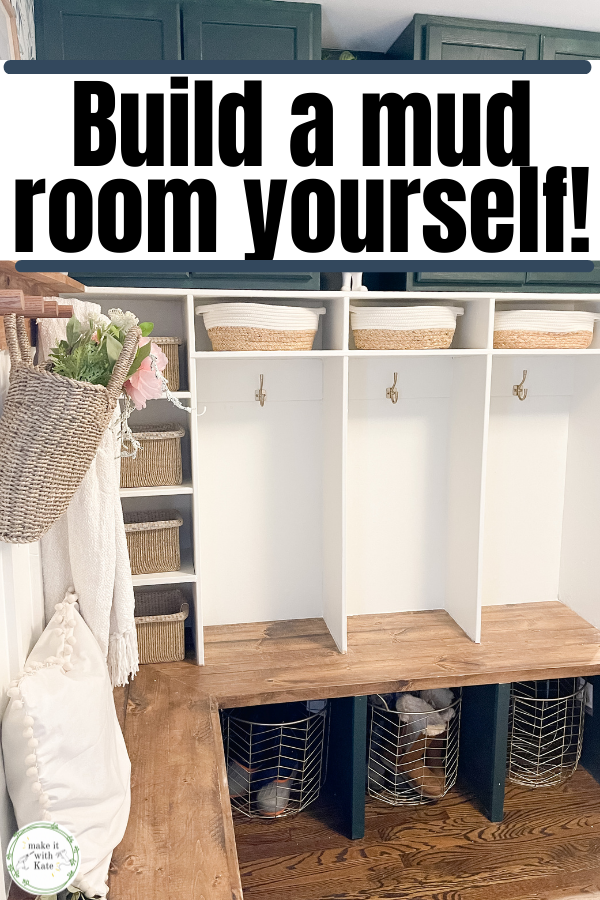This was such a labor of love, and I’m so happy with how the entire project turned out! Creating my own DIY mudroom allowed me to really bring my design to life, and customize all of the nooks and crannies to fit our lifestyle.
This is a recap posts of all of the pieces that brought this mudroom together. Included are a corner bench, cabinets, a locker unit, and a peg rail board and batten wall with wallpaper.

Building the DIY Mudroom
Below are the links to all of the various components to this mudroom build. If you haven’t seen them yet, check them out first to see how everything is built, then come back here for FAQ’s and styling info.
- DIY Mud Room Part 1: DIY Mudroom Bench
- DIY Mud Room Part 2: Adding Mudroom Locker Cabinets
- DIY Mud Room Part 3: DIY Mudroom Lockers
- Mud Room Part 4: DIY Board and Batten with Peg Rail Top

FAQ’s about the Mud Room
While building this mud room, I documented the entire process about how I built everything in my Instastories. You can follow me on Instagram and find all of those videos saved in my Highlights – titled Mud Room (there are a few of them for each component).
While sharing that process, I got quite a few questions and want to share some of them here. I’ll update this if more come in – if you have a question to add, send me a message on IG or leave a comment on this post!

What paint color did you use?
The color of these cabinets and the bench cubbies is Salamander by Benjamin Moore.
The white used on the batten wall and the lockers is White Dove by Benjamin Moore.
I used Stix primer on the cabinets and the plywood.
The stain used on the bench top and the peg rail is Varathane Early American.

Where is the wallpaper from?
This wallpaper is SO pretty! And it’s peel and stick which is super easy to apply (and remove).
This one is from Target, the Roommates Olive Branch Magnolia Home Wallpaper in Green.

Where are the stock cabinets from?
These stock cabinets are from Lowe’s. I have purchased them from Home Depot as well for other projects such as my DIY Built-ins with Stock Cabinets.
Here are more tips about using stock cabinets for built ins.
What tools did you use?
My favorite brand of tools to use is Ryobi. I have the cordless kit with rechargable batteries. Having everything be the same system where I can easily pop a battery out and into another tool is so helpful!
What kind of wood did you use?
The bench is made of 3/4″ sanded plywood for the cubbies, and common board for the bench top.
The lockers are made of 3/4″ plywood and wood trim.
The cabinets were purchased stock cabinets.
The peg rail and batten is made of common board and wooden dowels.
How much did the project cost?
- Lumber (plywood, common board, trim): $220
- Paint, primer and stain: $80
- Cabinets: $140
- Hardware: $30
- Wallpaper: $50
Total cost = roughly $520
I did already have some scrap wood for things like the floating shelves, and I also had screws and all of the tools needed.
(I did have a quote for much less of a build and not as much storage space for almost $4,000 – so this was a huge cost savings for me!)
What are the measurements?
The locker wall is 69″ long, with the cabinets being 30″ wide each.
Each locker unit is 18″ wide, and the shelving unit is 15″ wide.
The bench is 20″ tall and the cubbies are 18″ wide.
The batten wall and peg board is 46″ wide.

Styling the Mud Room
Once the entire mud room unit was built, the really fun part came in the styling!
Everything seen here is purchased primarily from either Home Goods or Target.
All of the baskets seen here including the wicker baskets and the large wire shoe baskets are from Home Goods, as is the wreath hanging on the door.
The hooks inside the lockers are from Home Depot.
The hanging basket, faux plants, and shelf decor are all from Target.
Is any of this styling functional? No. But, it sure makes the room look cute.

Building floating shelves between the cabinets
One aspect of the mud room that I didn’t touch on at all in any of the tutorial posts are the floating shelves in between the cabinets.
The space between the cabinets was painted green on the wall, but that area didn’t look finished without the shelving.
I made the floating shelves by taking two 1″ square dowels on each end, nailing a piece of 1/4″ plywood to the top and bottom of the dowels so that the shelf was a hollow cube.
I then placed them between the cabinets, and nailed through the inside of the cabinets into the dowels on the ends of the shelves.
Then, I added a 1×2″ piece along the front from cabinet to cabinet. I stained these to match the top of the bench and the peg rail with the Varathane Early American as well.





Looks beautiful! How deep is the bench the doesn’t have the lockers above it?